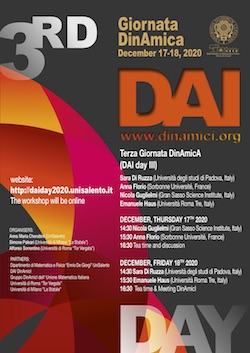17th December, 2020
- 14:30 - 14:45 Welcome address
- Prof Fabio Pollice, Rector of Università del Salento
- Prof Michele Campiti, Head of the Department of Mathematics and Physics "Ennio De Giorgi"
- 14:45 - 15:30 Nicola Guglielmi (Gran Sasso Science Institute, Italy)
- Approximating Lyapunov exponents of switching systems
- 15:30 - 16:15 Anna Florio (Sorbonne Université, France)
- Spectral rigidity of contact 3D Axiom A flows
- 16:30 - Tea time and discussion
18th December, 2020
- 14:30 - 15:15 Sara Di Ruzza (Università di Padova, Italy)
- Symbolic dynamics in a binary asteroid system
- 15:30 - 16:15 Emanuele Haus (Università Roma 3, Italy)
- Normal form and existence time for the Kirchhoff equation
- 16:30 - Tea time & DinAmicI Meeting
The link to the online seminars:
Zoom Link: zoom.us/j/2678872214
Speaker: Anna Florio (Sorbonne Université, France)
Title: Spectral rigidity of contact 3D Axiom A flows
Abstract: We show a rigidity result for two 3-dimensional contact Axiom A flows. More precisely, if the restriction of the flows to some basic set is orbit equivalent and iso-length-spectral, then the dynamics on the basic sets are conjugated through a homeomorphism of class $C^{1,\beta}$, in Whitney sense, for some $\beta\in(0,1)$, which also preserves the contact structures. The ideas are reminiscent of the work of Otal. As a consequence, interesting spectral rigidity results can be deduced for $C^k$ open dispersing billiards. This is a joint work with Martin Leguil.
Speaker: Nicola Guglielmi (Gran Sasso Science Institute, Italy)
Title: Approximating Lyapunov exponents of switching systems
Abstract: In this talk I will discuss a new approach for constructing polytope Lyapunov functions for continuous-time linear switching systems. The proposed method allows to decide the uniform stability of a switching system and to compute the associated Lyapunov exponent with an arbitrary precision. The method relies on the discretization of the system and provides - for any given discretization step-size - a lower and an upper bound for the Lyapunov exponent. Then I will briefly discuss asymptotic stability of continuous-time systems with mode-dependent guaranteed dwell time. These systems are reformulated as special cases of a general class of mixed (discrete-continuous) linear switching systems on graphs, in which some modes correspond to discrete actions and some others correspond to continuous-time evolutions.I will give a few examples to illustrate the methodology. Mainly inspired by joint works with Vladimir Yu. Protasov (University of L’Aquila and Moscow State University) and Marino Zennaro (University of Trieste).
Speaker: Emanuele Haus (Università Roma 3, Italy)
Title: Normal form and existence time for the Kirchhoff equation
Abstract: In this talk I will present some recent results on the Kirchhoff equation with periodic boundary conditions, in collaboration with Pietro Baldi.
Computing the first step of quasilinear normal form, we erase from the equation all the cubic terms giving nonzero contribution to the energy estimates; thus we deduce that, for small initial data of size $\varepsilon$ in Sobolev class, the time of existence of the solution is at least of order $\varepsilon^{-4}$ (which improves the lower bound $\varepsilon^{-2}$ coming from the linear theory).
In the second step of normal form, there remain some resonant terms (which cannot be erased) that give a non-trivial contribution to the energy estimates; this could be interpreted as a sign of non-integrability of the equation. Nonetheless, we show that small initial data satisfying a suitable nonresonance condition produce solutions that exist over a time of order at least $\varepsilon^{-6}$.
Speaker: Sara Di Ruzza (Università di Padova, Italy)
Title: Symbolic dynamics in a binary asteroid system
Abstract:We consider a system of three point masses undergoing Newtonian attraction. Two of them (“binary asteroids”) have equal mass, while the third one (“planet”) is much heavier. The three masses are constrained on a plane. The two lighter particles orbit one to the other, while the tra- jectory of the third particle is external to the two, and far. We look at the secular motions of this system, meaning that, from a reference frame centred with one of the asteroids, we average out the position of the other asteroid, and look at the movements of the eccentricity and the pericenter of its instantaneous ellipse, as determined by the attraction by the planet. In the limit when the planet describes a circular trajectory with infinite radius, the asteroidal ellipse periodically squeezes to a segment while the pericenter oscillates about an equilibrium. The question we ask concerns the onset of chaos, once the planet exercises its attraction at a large, but finite distance from the asteroids. Our analysis is purely numerical. Based on covering rlations as in a recent paper by A. Gierzkiewicz and P. Zgliczynski (2019), a topological horseshoe is highlighted, indicating symbolic dynamics.This is a joint work with Jérôme Daquin and Gabriella Pinzari.

